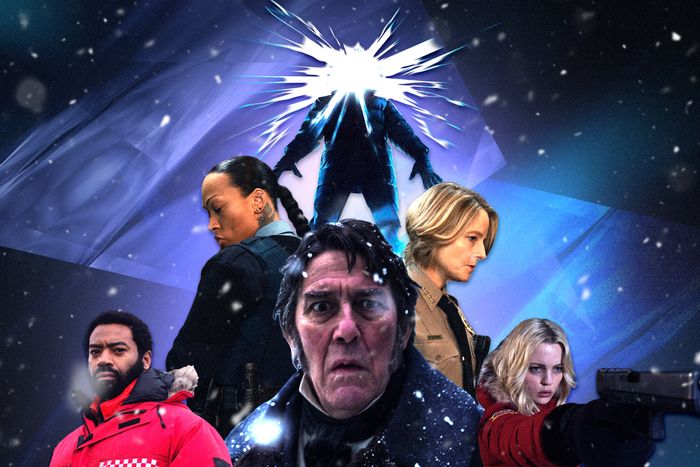
As an elevator pitch, it’s hard to beat the basic premise of Night Country: “What if True Detective was also The Thing?” Set in the fictional town of Ennis, Alaska, a small mining community way up in the Arctic, the fourth season of HBO’s frequently spooky mystery series follows two detectives as they try to piece together what horrible fate befell a group of scientists from a secluded research facility near the town.
That Night Country is partially inspired by The Thing, John Carpenter’s 1982 horror masterpiece about a shape-shifting alien who attacks a group of researchers at an Antarctic base, is no secret. During the premiere, when Jodie Foster’s character inspects the common room where the scientists were last seen, a copy of The Thing clearly stands out among the rows of DVDs as a very deliberate Easter egg. The grotesque, tentacled shadow of The Thing looms large over a whole suite of movies and TV shows about terror near the Earth’s poles. They are inherently inhospitable, dangerous, and strange places that lend themselves to the horror genre. Polar horror (so named to include both Arctic and Antarctic scares), is something beyond just snowy horror or cold weather spooks — films like Gremlins or Misery don’t fit the bill. Scary things can happen during the winter anywhere. What makes polar horror so special is that nobody comes to the top or bottom of the world by accident. Researchers or explorers make the choice to go where people aren’t supposed to be, willingly going into the frigid unknown where the sun might never rise. The terrors they experience, then, feel like a result of some sort of icy hubris.
If True Detective: Night Country has unleashed a hunger for other tales of terror at the poles, not unlike an eldritch alien monstrosity emerging after a millenia frozen in the ice, here are a dozen movies or TV shows that will keep you scared the whole endless night.
The Thing From Another World (1951)
Though (rightfully) eclipsed by John Carpenter’s far superior remake 30 years later, the first Thing movie is a chilling bit of Arctic terror in its own right. An adaptation of a horror novella from the late ‘30s called Who Goes There?, this black and white creature feature eschews the titular Thing’s shape-shifting abilities that Carpenter would later successfully bring to terrifying life. Instead, a group of scientists and service men discover a crashed craft near the north pole and must try to survive when the creature inside — a monstrous alien plant in the shape of a man — hunts them down inside their outpost. It’s a less subtle sort of polar horror than many of the best examples of the subgenre, but it does feature one of its hallmarks: An isolated group of trapped people blaming and turning on each other. (But, of course, the real threat here is the killer plant-man, who is also sort of a stand-in for Communism.)
The Thing (1982)
Though it bombed, hard, when it was initially released, Carpenter’s take on The Thing is now widely regarded as one of the best movies ever made, not just the North Star of polar horror. (The film placed No. 118 on Sight & Sound’s extremely prestigious list of the 250 best movies.) A tour de force of suspense, shock, and practical effects — not to mention Kurt Russell’s charisma and incredible hair — make The Thing the movie that all other players in the subgenre must contend with. Even when they’re not paying overt homage to The Thing, the movie is lurking in the DNA of everything that would come after it.
The X-Files, “Ice” (1993)
Originally intended to be a cost-saving “bottle episode,” this first-season X-Files episode would end up wildly exceeding its budget. The money was well spent, luckily. Agents Mulder and Scully go to a remote Alaskan research facility to investigate a murder-suicide, only to discover that something the scientists dug up as part of an ice core sample has unleashed a 250,000-year-old worm that can infect and control people. Though it lacks the gory, blockbuster effects of The Thing, the paranoia that ensues as Mulder, Scully, and the various researchers attempt to determine who among them might be infected by the worm is clearly inspired by the film from a decade earlier — and it’s effective, too. That “Ice” doesn’t have grand ambitions beyond being a really good retread of The Thing is not an issue when the source material is that sublime.
The Twilight Zone, “Cold Fusion” (2003)
Nestled between the original Rod Serling Twilight Zone from the ‘60s and the Jordan Peele reboot was a third, forgotten Twilight Zone series that aired for one season on the now-defunct UPN network. “Cold Fusion,” an episode from later in the series’ run, offers an especially psychological spin on the basic premise established by The Thing. Physicist Paul Thorson (Sean Patrick Flanery) travels to a remote Alaskan research facility to investigate issues surrounding a mysterious Project Gemini. Without spoiling the twist (which Twilight Zone fans might see coming but is a good one nonetheless), Thorson comes into conflict with the various researchers, including one played by Ian McShane. There’s more — or perhaps, less — to them than initially meets the eye, and “Cold Fusion” flips the script on The Thing by having the source of all the unraveling be a human creation rather than an eldritch discovery.
Pele’s Twilight Zone, for what it’s worth, had an episode that could be considered Polar Horror, but the Steven Yeun-led “A Traveler” doesn’t hit quite as many of the typical tropes as the best examples of the subgenre do.
Black Mountain Side (2004)
This indie Canadian movie is very clearly indebted to The Thing, and while the limitations of its miniscule budget, lackluster actors, slow-to-a-fault pacing, and lack of score don’t put it anywhere in the same league as Carpenter’s classic, Black Mountain Slide has moments that will make your spine tingle. The setup is familiar, at this point: Researchers at a remote Alaskan outpost make a discovery, unwittingly unleashing something that causes them to turn on each other. Black Mountain Side introduces cosmic horror into the equation, and while the movie as a whole can’t quite live up to its eldritch, unfathomable ambitions, when it works it really works — especially in scenes when a creature that’s not not some sort of deer lurks in the pitch blackness just outside the outpost’s borders.
6.
Alien v. Predator (2004)
Your mileage may vary on whether or not AVP — which boasts the hall-of-fame tagline “Whoever Wins… We Lose” — is actually scary or just a silly monster mash-up. But, its choice of setting, an uninhabited island off the coast of Antarctica, puts it firmly in the tradition of the Alien and Predator movies. In Alien, part of the horror came from how isolated Ripley and the rest of the crew of the Nostromo were when the Xenomorph attacked. (“In space, no one can hear you scream” is another all-time tagline.) Predator’s jungle setting wasn’t quite as desolate and inhospitable, but there was still a clear sense that our muscled protagonists were going somewhere they weren’t supposed to be — somewhere a stranger, deadlier creature was more at home. The frozen wastes of the Antarctic coast, then, are a fitting location for the two aliens’ showdown.
The Last Winter (2006)
Alien “things” from another world are one sort of scary. Climate change is another. Ron Perlman and Connie Britton star in this apocalyptic piece of Polar Horror about oil drillers and environmentalists who are way up north when the Earth releases long-frozen forces. The Last Winter makes exceptional, terrifying use of the vast, empty white canvas that is that is the Arctic, populating it with hoofed horrors and the looming concern of what could happen, in real life, when all this ice melts away. The Last Winter is probably the hidden gem among all these recommendations.
30 Days of Night (2007)
30 Days of Night breaks slightly from the typical requirements of the Polar Horror subgenre because the town of Barrow, Alaska, (a real place that has since been renamed Utqiaġvik) is not a hubristic or doomed research facility but a community, albeit one that’s exceedingly remote and north of the Arctic circle. And, yet, 30 Days of Night must be included in this list because the vampires that violently attack the town prey on Barrow’s isolation and its perpetual darkness. You can only have this type of blood-sucking in such close proximity to the North Pole.
Fortitude (2015-2018)
The titular Norwegian settlement was established some time ago, and when this three-season British series starts out it seems nice enough, if a little insular. But, as is the case with so many examples of Polar Horror, this place is not somewhere people are supposed to live, no matter how long they’ve been there. The constant cold and darkness are always threatening to creep into the veneer of civilization that’s been constructed on this island, and when the ice starts melting and people begin to go insane — to say nothing of how crazy things get after the first season — it feels chillingly inevitable.
The Terror Season One (2018)
It speaks to how scary the Arctic is that you could outright remove the supernatural elements from The Terror’s first season and it would still be absolutely horrifying. An adaptation of Dan Simmons’ novel of the same name, AMC’s The Terror begins with a true story and fills in all the terrifying blanks. In the 1840s, HMS Erebus and the unfortunately named HMS Terror set sail trying to find the fabled Northwest Passage. They got stuck in the ice and everybody died. Those are the facts, but The Terror expands on them with a season of frozen, isolated misery and conditions that would be bad enough without a mythical beast known as a Tuunbaq hunting down the members of Captain Sir John Franklin’s lost expedition. Starring Jared Harris, Tobias Menzies, and Ciarán Hinds, The Terror is the best Polar Horror since The Thing, hands down.
The Head (2020)
It’s perhaps harsh, but not unfair, to call The Head a sort of “lite” True Detective: Night Country. The series, which is in English despite being a production of HBO Asia and Hulu Japan that was helmed by a Spanish director, follows a group of researchers who return for their shift at a facility near the South Pole only to discover that the team who stayed behind during the six months of night are all dead or missing — save for one member. While more of a psychological thriller than it is a true polar horror series, The Head knows what its lineage is: the scientists make a point of watching The Thing every year before the winter shift begins. The Head doesn’t have True Detective’s craft, mysticism, or Jodie Foster, but it does have a spooky murder at the end of the world. It’s probably the closest substitute for Night Country fans who can’t wait for the next episode. (A Murder at the End of the Worl, for what it’s worth, could arguably count, too, though it’s more firmly in the sleuth “whodunit” mystery genre than some of these other frosty offerings.)
The North Water (2021)
If one of the selling points of The Terror was how hostile it made the Arctic before adding supernatural horrors, another AMC show from a couple years later plays the premise coldly straight. There are no ghosts or monsters to be found in this five-part series about a whaling ship in the 1850s beyond those aboard the ship and the darkness of their souls. Colin Farrell plays a psychotic harpooner who is at odds with the protagonist, the ship’s surgeon, who has a grim past of his own. With all the murder, rape, and seal-clubbing, there’s no need for occult horrors.




